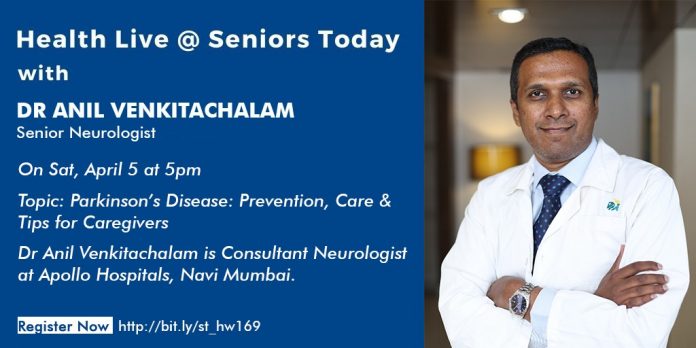On 05 Apr, 2025, Seniors Today hosted their weekly Health Live Webinar with a Senior Neurologist, Dr Anil Venkitachalam who spoke on and answered questions about Parkinson’s Disease: Prevention, Care and Care giving tips to mark World Parkinson’s Disease Day which is celebrated on 11 Apr.
About Dr Anil Venkitachalam
Dr.Anil Venkitachalam is a Consultant Neurology at Apollo Hospitals Navi Mumbai. He is a highly experienced neurologist with a career spanning over 14 years. He holds an MBBS from Dr. D.Y. Patil Medical College, Mumbai (2002], an MD in General Medicine from Sri Ramachand ra Medical College, Chennai (2005], and a DM in Neurology from the same institution (2009). He further honed his expertise through a Post-Doctoral Fellowship in Movement Disorders at the University of Alberta, Canada, a globally recognized center of excellence for Parkinson’s disease and movement disorders.
Previously, he has held esteemed positions such as Assistant Professor and Consultant Neurologist at Amrita Institute of Medical Sciences, where he was responsible for managing the adult neurology and movement disorders unit.
He is proficient in advanced therapies such as Deep Brain Stimulation (DBS] and Botulinum toxin injections. Additionally, he has extensive experience in managing acute neurological emergencies, neurophysiology, and comprehensive care for degenerative diseases.
An active researcher, Dr. Venkitachalam has contributed to several international publications and clinical trials focusing on Parkinson’s disease, Huntington’s disease, and Hereditary Spastic Paraplegia. He is also a passionate educator, mentoring medical students, residents, and fellows in neurology.
He has been a part of various clinical trials such as the PR0 FESS study and has published 20 research articles in international and national clinical journals. He is currently an active member of the International Parkinson and Movement Disorders Society and the Movement Disorders Society of India.
Parkinson’s disease is very common and is often associated with tremors by the German population.
There is a lot of fear and anxiety associated around the disease and its diagnosis, especially in the senior citizens.
Parkinson’s disease is a progressive neurodegenerative disorder; which means there is a part of the brain that starts shrinking and undergoes degeneration.
Traditionally, Parkinson’s is a disease of the elderly. More than 1% of the population of the world is affected.
The incidence of the disease increases with age (incidence increases over the age of 60). It increases by 1% every year.
Over the age of 80 years, the incident significantly increases. Chances of getting Parkinson’s disease increases by over 20%.
It further increases significantly over the age of 85 years. Chances of getting Parkinson’s disease increases by over 40%.
As your age increases, the chances of you developing Parkinson’s increases.
In a small subset of the population, Parkinson’s disease can also present in the younger age group. Making it not just a disease of the elderly.
Two of the major and most common neurodegenerative diseases are:
- Parkinson’s disease, which is mainly a disease that affects the movement and motor aspect of the body
- Alzheimer’s disease, which affects the memory and personality (a form of dementia)
Parkinson’s disease affects:
- People over the age of 60
- Males > Females
- Individuals with a family history of Parkinson’s in the family
- Caucasian population
Dopamine is a major neurochemical which acts as a fuel for the brain. It also helps in the process of motor movement.
Basal ganglia is a small structure in the brain which helps in movement.
In Parkinson’s disease, there is degeneration of the basal ganglia (substantia nigra region of the basal ganglia). As the substantia nigra degenerates, the production of the dopamine drops. Leading to falls in the levels of dopamine. As the level of dopamine comes down, the patient presents with signs and symptoms of Parkinson’s disease.
Signs and symptoms of Parkinson’s disease:
- Motor symptoms:
– Tremors- resting tremor
– Rigidity
– Akinesia
– Loss of postural reflexes
– Slowness of movement
– Stiffness
– Reduced arm swing
– Loss of voice
– Mask like face
- B) Non motor symptoms:
– Severe constipation
– Bloating sensation in the abdomen
– Unexplained aches and pains
- C) Urinary symptoms:
– Nocturia
– Urinary incontinence
- D) Neuropsychiatric symptoms:
– Depression
– Loss of empathy
– Behavioural issues
– Cognitive issues such as dementia, hallucinations
– Anxiety
The exact cause of Parkinson’s disease has not yet been identified but there are certain factors which are postulated to cause Parkinson’s disease. These include:
- Genetic predisposition
- Lifestyle and environmental triggers
- Certain drugs such as dopamine blockers, psychiatric medications can trigger a Parkinson’s like episode
- Infectious agents
Parkinsonism is a group of disorders which look like Parkinson’s disease. It can be drug induced Parkinson’s, or caused due to metabolic problems, infections, etc.
There are other diseases which mimic Parkinson’s disease but are far more aggressive. These are called Atypical Parkinson’s or Parkinson’s Plus.
We need to identify these diseases because traditional Parkinson’s disease can be managed by medication, whereas atypical Parkinson’s is far more aggressive in nature and is less receptive to medication.
A neurologist will be able to identify whether you have classical Parkinson’s disease of atypical Parkinson’s disease. And then decide the further course of action.
Stages of Parkinson’s disease:
- Stage 1: mild Parkinson’s disease
- Stage 2
- Stage 3
- Stage 4
- Stage 5: extreme form of Parkinson’s disease where the patient is immobile, bed ridden, needs help to perform daily activities
Parkinson’s disease is a clinical diagnosis. There is no scan/ investigation available to confirm the diagnosis.
There is a F- dopa scan which is available, but it is highly expensive.
Treatment options available included
- Medical
- Surgical
- Device assisted
- MRGFUS








